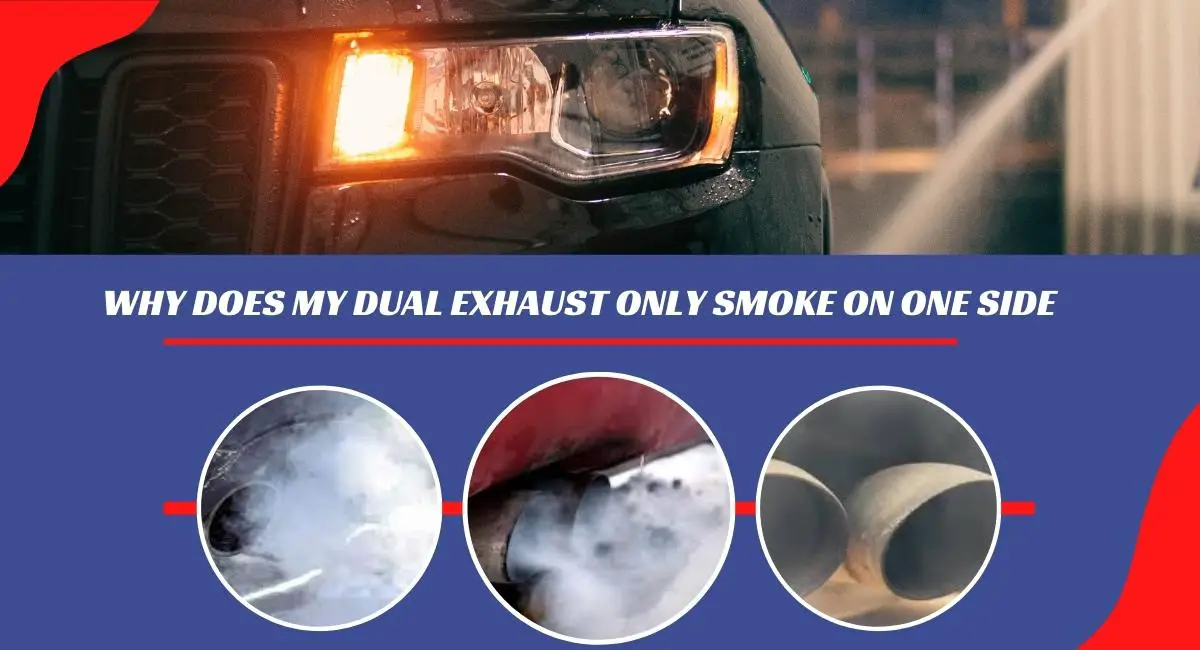Have you ever fired up your car, revved the engine, and watched an unsettling plume of smoke billowed from one side of your dual exhaust? While this might seem like a cause for concern, this offbeat symphony of smoke is more common than you might think. But what causes it? How does it impact your vehicle’s performance, and how can you rectify it?
Often the presence of dense smoke from the dual fuel exhaust smoking on one side is linked to issues such as a compromised head gasket, a faulty cylinder, or a fractured engine block, leading to the burning of coolant. Typically, heavy white exhaust smoke signals a coolant leak, which could induce overheating and pose a significant threat to your engine’s integrity.
But there’s more. This comprehensive guide delves into the mechanics of dual exhaust systems, the implication of smoke emissions, and the surprising link between exhaust smoke and water. We’ll also explore possible causes and solutions to this perplexing problem.
Understanding the Dual Exhaust System
As the name suggests, a dual exhaust system is a type of exhaust setup that utilizes two separate exhaust paths for the engine’s gases. These systems are commonly found in high-performance cars, though they’ve also become a popular modification for many car enthusiasts.
The primary components of a dual exhaust system include the exhaust manifold, catalytic converters, mufflers, and tailpipes.
Exhaust Manifold
This component collects the exhaust gasses from the engine’s cylinders and directs them into one pipe. In a dual exhaust system, the engine’s exhaust is mostly split into two right from the manifold. With cylinders arranged in a V-shape, V-engines lend themselves naturally to dual exhaust systems as each bank of cylinders can be linked to a separate exhaust pipe.
Catalytic Converters
These are important for minimizing the vehicle’s environmental impact. The converters chemically alter the exhaust gases, turning harmful substances like carbon monoxide, nitrogen oxides, and unburned hydrocarbons into less toxic substances like carbon dioxide and nitrogen gas. There are usually two catalytic converters in dual exhaust systems, one for each exhaust path.
Mufflers
Mufflers’ design reduces the noise produced by exhaust gasses. In dual exhaust systems, each exhaust path will typically have its muffler. It helps reduce noise and contributes to the improved performance associated with dual exhaust systems as it minimizes back pressure.
Tailpipes
These are the final part of the exhaust system. They carry the processed gases from the mufflers to the vehicle’s rear (or side). In a dual exhaust system, there will typically be two tailpipes, contributing to the system’s distinctive look.
Dual exhaust systems offer several advantages, including improved engine efficiency and power, better fuel economy, and faster acceleration. They can reduce back pressure, which helps the engine to breathe easier and burn fuel more efficiently. The result is more horsepower and torque, making the vehicle more fun.
They also give vehicles a unique aesthetic appeal and a more aggressive exhaust note. Dual exhaust systems are popular for many vehicle owners since they have performance benefits.
It’s important to note that dual exhaust systems require regular maintenance and checkups to keep them running efficiently and safely. Problems in the system can lead to uneven exhaust flow or smoke from one side of the system, an issue we’ll discuss in more detail later in this article.
Reasons for White Smoke Coming Out of an Exhaust
While common, smoke emission from the exhaust can reveal much about your vehicle’s health. Typical smoke types are white, black, and blue, each indicating different issues.
The focus here is on white smoke coming out of the exhaust, often a sign of coolant entering the combustion chamber due to a blown head gasket, a cracked engine block, or a malfunctioning cylinder head.
Continued white smoke emissions can potentially lead to overheating and serious engine damage. It’s important to discern between a short puff of white smoke during a cold start (usually harmless condensation) and continuous white smoke while driving, necessitating immediate attention.

Why Does My Dual Exhaust Only Smoke on one Side
Witnessing smoke billowing out of only one side of your dual exhaust can be both perplexing and disturbing. This occurrence is typically not standard and could be a sign that your vehicle is experiencing certain issues.
A dual exhaust system has two paths for the engine’s exhaust gases. If smoke comes out of just one side, it could mean an issue causing an imbalance in this system.
Here are some of the possible reasons:
Blockage in the Exhaust System
One potential cause could be a blockage in one part of your exhaust system. This blockage could be due to accumulated carbon deposits, a damaged muffler or pipe, or even a foreign object that has somehow found its way into your exhaust. This blockage could cause the exhaust gases to back up, leading to smoke appearing on one side.
Engine Issues
The problem could also lie within your engine. If one side of the engine is burning oil or coolant due to issues like worn piston rings or a leaking head gasket, it could result in smoke from one side of the dual exhaust system.
Uneven Fuel Distribution
If the fuel distribution is skewed, one side of the engine may receive more fuel than the other, leading to incomplete combustion and white smoke from one side of the dual exhaust.
Malfunctioning Catalytic Converter
The catalytic converter’s job is to convert harmful engine gases into less toxic substances. If one of the converters in your dual exhaust system is malfunctioning, it might not process the gases properly, leading to smoke from one side.
If you notice that your dual exhaust is only smoking on one side, diagnosing and addressing the issue as soon as possible is essential. Ignoring the problem could lead to more serious damage over time, resulting in costly repairs. It’s always best to consult a professional mechanic to get an accurate diagnosis and the appropriate solution.
This is Why Water is Coming Out of Exhaust While Idling
Have you ever noticed water trickling out of your exhaust pipe while your vehicle idles? It is typically the result of condensation in the exhaust system cooling down. A correlation exists between this water and white smoke.
When the water vapor in the exhaust gases cools down, it turns back into a liquid state and, combined with certain light conditions, can give the appearance of white smoke. In normal amounts, this is a harmless by-product of combustion. However, excessive water or ‘smoke’ could indicate a more serious issue.
Why There’s White Smoke from One Side of the Dual Exhaust
So, why does white smoke come from only one side of your dual exhaust? White smoke from your exhaust can cause concern, as it often signals that something isn’t quite right with your vehicle.
While occasional puffs of white smoke are usually harmless and often due to condensation within the exhaust system, continuous white smoke can indicate a more serious problem.
Several factors could contribute to this, including a blockage or damage in one part of your exhaust system, uneven fuel distribution, or a problem with one side of the engine itself.
Environmental factors and driving habits can exacerbate these issues. One-sided smoke signals an imbalance in your vehicle’s performance and could indicate an underlying problem, such as a leaking gasket or a problematic injector.
How to Solve Dual Exhaust Smokes Only on One Side Problem
Addressing the issue of your dual exhaust system emitting smoke only on one side involves identifying the root cause and implementing the appropriate solution. This issue can originate from various sources, so it’s essential to diagnose correctly before initiating any repairs.
Here’s a general guide on how to approach this:
- Visual Inspection: Start by conducting a visual inspection of your exhaust system. Look for any signs of physical damage, such as cracks or holes that may be causing the imbalance in smoke distribution.
- Examine for Blockages: Check your exhaust system for blockages. These can occur due to carbon build-up or foreign objects and can restrict the flow of exhaust gases.
- Check the Engine: Evaluate your engine, specifically looking for potential issues that might cause one side to burn more oil or coolant, such as a leaking head gasket or worn piston rings.
- Inspect Fuel Distribution: The issue may also be due to uneven fuel distribution. In this case, inspect the fuel injectors and related components to ensure they’re working correctly.
- Examine the Catalytic Converters: If one side of the exhaust is smoking, it could mean that the corresponding catalytic converter is malfunctioning. Get both converters checked to ensure they effectively convert harmful gases into less toxic substances.
- Professional Assistance: If the problem persists after these checks, it’s advisable to seek professional help. A certified mechanic will have the knowledge and tools to perform a comprehensive diagnosis and suggest an appropriate fix.
Possible solutions to this problem range from simple fixes like removing a blockage or replacing a damaged part to more complex solutions like repairing or replacing components of the engine or exhaust system. Regular vehicle maintenance, including timely oil changes and check-ups, can help prevent such issues.
Conclusion
Understanding the peculiar problem of one-sided smoke emission from your dual exhaust is instrumental in maintaining your vehicle’s health. Regular checks and preventative measures are imperative. The mystery of “Why does my dual exhaust only smoke on one side” reminds us of the intricate systems at work within our vehicles, reinforcing the importance of ongoing care, vigilance, and knowledge.
